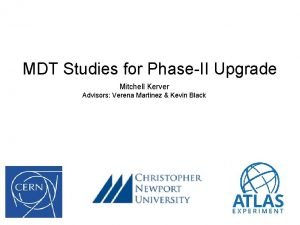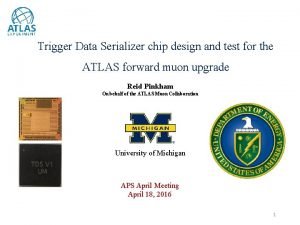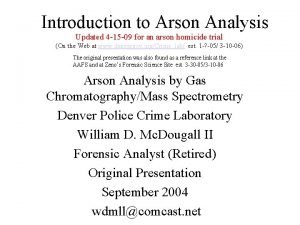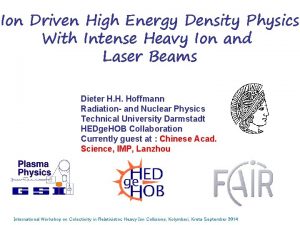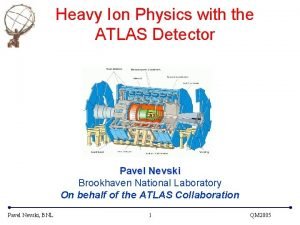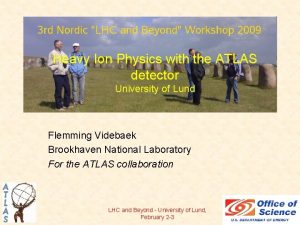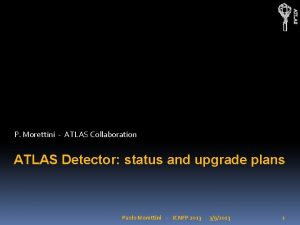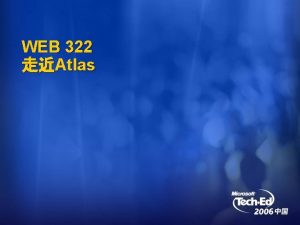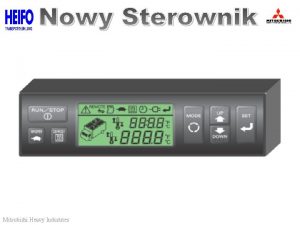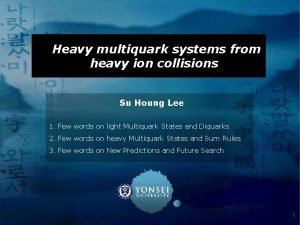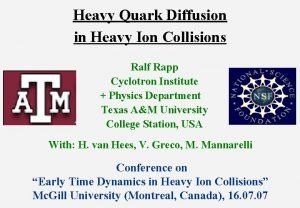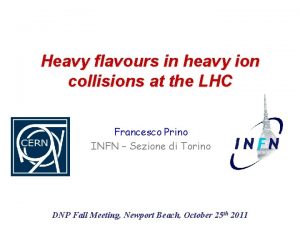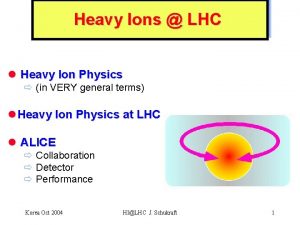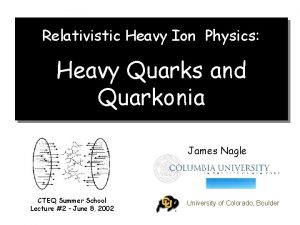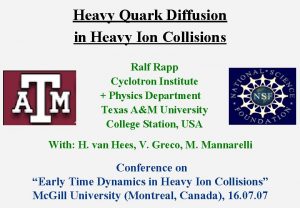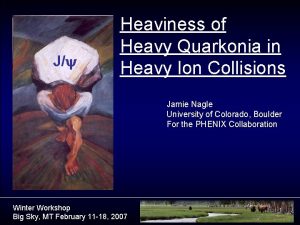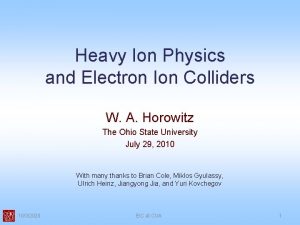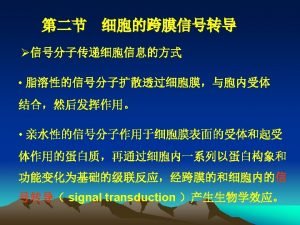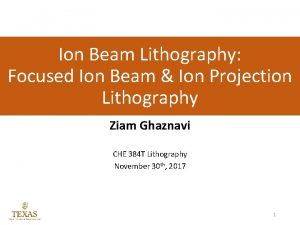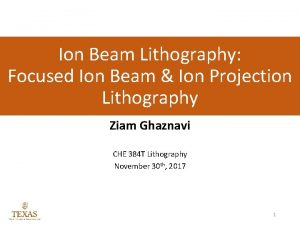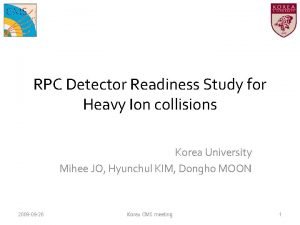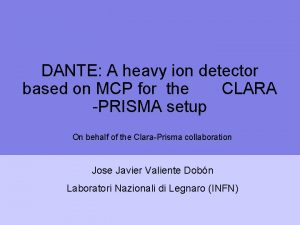Heavy Ion Measurements with the ATLAS Detector at









































- Slides: 41

Heavy Ion Measurements with the ATLAS Detector at the LHC Brian A. Cole, Columbia University June 28, 2007

LHC Heavy Ion Program: Key Questions • What is the mechanism for initial particle production at the LHC? – Production from a saturated initial state? • How rapidly do produced particles thermalize isotropize, what is the mechanism? or – Faster than RHIC, slower ? • How do high-energy quarks and gluons interact in the quark gluon plasma? – What is the response of the medium? • What is the screening length of the QGP? • What are the quasi-particles of the QGP? • How does the QGP hadronize? 2

LHC Heavy Ions Program: Key Questions 3

LHC Heavy Ions Program: Key Questions 4

Parton Density Collectivity RHIC Low x High p. T LHC Physics Summary ? ? 5

Jet Tomography • At RHIC, studied via leading hadrons – Statistics suffer from frag. function rates – Quenching geometric bias – No direct measure of frag. function. • At LHC: – Full jets, high p. T, large rates, b jets, di-jet, -jet ÞPrecision jet tomography 6

Jet Tomography • At RHIC, studied via leading hadrons – Statistics suffer from frag. function rates – Quenching geometric bias – No direct measure of frag. function. • At LHC: – Full jets, high p. T, large rates, b jets, di-jet, -jet ÞPrecision jet tomography 7

Parton Showers, Hard Radiation @ LHC • Copious hard radiation in high Q 2 finalstate parton showers, F ~ 1/k. T • Both an opportunity and a challenge – Understanding jet quenching more difficult – Potentially: time-dependent probe of medium • Resolving hard radiation in jets a must! 8

The ATLAS Central Detector • Inner tracking, EM and Hadronic calorimeters, external muon spectrometers 9

ATLAS from the Inside 10

ATLAS Zero Degree Calorimeter TAN region, z=140 m Experiment Simulation Test beam @ CERN 10. 06 p+p events, w/ precision EM module ZDC Prototype @ CERN 10. 06 11

ATLAS Acceptance 12

ATLAS Acceptance Hadr Calorimeter EM Calorimeter Muon spectrometer Si Tracking ZDCs Bulk observables , 0, isolated , ’ Jets 13

ATLAS Acceptance Bulk observables , 0, isolated , ’ Jets 14

ATLAS Inner Tracker & Tracking • 3 layers Si pixel • 8 layers Si strip • TR tracker Minimum bias, | | < 2. 5 • “Vanilla” ATLAS track reconstruction – But with only Si detectors • Tuned parameters but – No dependence to tracking cuts (yet) – No verification with calorimeter clusters (here) efficiency 15

ATLAS Tracking Fake track fraction • High fake track rates for | | > 2. – Increasing hit density – Material in Si tracker ÞMore work needed Þe. g. tighter cuts @ larger • For | | < 1, central Pb+Pb (b = 2. 3 fm) – Excellent results using “vanilla” ATLAS track reconstruction | |<1 16

ATLAS Calorimetery Hadronic Barrel EM Barrel Forward EM Long. Segmentation EM End. Cap Hadronic End. Cap 17

EM Calorimeter Long. Segmentation Jet All too wide for single photons Back ground Background • Segmentation of first EM sampling layer so fine that heavy ion background is ~ negligible – Nchg + N < 1, ET ~ 30 Me. V • Fine rejection of neutral hadron decays • Clean 1 st sampling prompt isolation 18

ATLAS Heavy Ion: Primary Goals • Measure dnchg/d , d. ET/d (total+EM) – Characterize gross properties of initial state. – Test saturation predictions • Measure charged, inclusive , 0 elliptic flow – Probe early collective motion of (s/t/w)QGP • Measure jets, jet fragmentation, -Jet, di-jet, … – Precision tomography of QGP & its properties – Medium response to passage of quenched jet • Measure Upsilon production via + – Probe Debye screening in medium • Study low x hard processes in p-p, p-A – Study factorization violations, BFKL, saturation 19

Multiplicity from Si Hits • Count clusters in each of 3 pixel layers • Correction = • Apply to simulated events (single) HIJING, Pb+Pb, b = 2. 3 fm b = 10. 7 fm 20

Charged Multiplicity from Tracklets Φ Pixel “tracklets” η 1. Truth tracks (black) 2. “B-Layer” Hits 3. Layer 1 Hits 4. Matched Tracklets Histogram (yellow) – Hijing Points (black) – Raw tracklets (no corrections) 21

Charged Multiplicity from Tracklets • Tracklets provide a good estimate of multiplicity – < 20% correction • dn/d resolution ~ 2% – except for most peripheral events 22

ET Measurement RHIC: ET /particle ~ constant Reproduced by HIJING b=2. 3, corrected d. Et/d ET in ATLAS (full simulation) 23

Centrality Determination 24

Reaction Plane w/ Calorimetry • Flow imposed on HIJING events via shift – a la Poskanzer and Voloshin, PRC 58 (1998). – Parameterization of RHIC v 2(Npart, p. T) • Characterize RP via v 2 correction factor – Comparison of subevents v 2 correction factor Comparison to true YRP 25

Reaction Plane w/ Tracks • As above, HIJING + shift w/ parameterized RHIC v 2(Npart, p. T) • Use reconstructed tracks p. T > 0. 5 Ge. V/c, | |<2. 5 v 2 correction factor • Reaction plane resolution via 26

Jets in A+A Jets from PYTHIA in 0. 1 x 0. 1 (logical) towers 27

Jets in A+A Jets from PYTHIA in 0. 1 x 0. 1 (logical) towers merged with b = 2 fm Pb+Pb event (HIJING) 28

Jet Reconstruction: ET Resolution • Pythia di-jet events with 35 < ET < 280 – Merged (post GEANT) into b = 2 fm HIJING events. • Reconstructed w/ R=0. 4 seeded cone algorithm – Seed: ET > 5 Ge. V in = 0. 1 x 0. 1 tower • Compared to R=0. 4 seeded cone algorithm on Pythia final-state particles. 29

Jet Reconstruction: b dependence – R = 0. 4 seeded cone jet algorithm – Here, Pythia jets in 70 < ET < 90 Ge. V Pythia Jets: 70 < ET < 90 Ge. V RMS • Pythia + HIJING performance vs b – Position resolution • Smooth evolution with centrality • By b =10 (Npart = 100) reach p-p performance. RMS E/E – Energy resolution 30

Jet Fragmentation Observables 31

k. T Jet Reconstruction • k. T jet algorithm has several advantages – Unseeded (better QCD predictability) – Explicitly accounts for angular ordered parton showers – Adapts to distorted (non-conical) jet shapes • With algorithmic optimization by Cacciari, becomes feasible in Pb+Pb (faster than cone) 32

k. T Jet Reconstruction (2) • Cacciari: – Use KT algorithm w/o subtraction. – Use fake jets to estimate background, subtract. • ATLAS: – Use jet using = 0. 1 towers to distinguish real & fake jets. Central Pb+Pb event + q. T = 140 Ge. V Pythia, EM energy only 1 4 3 2 1 3 4 2 33

k. T Jet Reconstruction (3) # jets Avg = 2. 0 RMS = 0. 9 ETmax / ET Very preliminary – ETmax / ET cut at avg. + 1 • 1 st study of performance of fast k. T algorithm in Pb+Pb ET / ET • KT algorithm with “R=0. 4” • But a crucial proof-of-principle showing the method works 34

Detection: Resolution & Efficiency • Good mass resolution • Large acceptance • Loss of efficiency near ~0 due to gaps, supports 35

Summary 36

ATLAS: Gamma-Jet Pythia + jet (75 Ge. V) superimposed on b=4 fm HIJING Pb+Pb event, full GEANT Gamma Jet 37

ATLAS: Gamma-Jet Pythia + jet (75 Ge. V) superimposed on b=4 fm HIJING Pb+Pb event, full GEANT Background subtracted Gamma Jet 38

ATLAS: Gamma-Jet, EM 1 st Layer Zoom in on barrel EM calorimeter 1 st sampling layer Gamma 1 st layer unaffected by Pb+Pb background isolation w/ 1 st layer ~ unaffected by Pb+Pb 39

1 2 p. T (Ge. V) Low-x Physics w/ ZDC π0 acceptance Log 10(x 2) • ZDC w/ precision EM module measures semi-hard 0, , , … production at x ~ 10 -6 in p-p and p-A collisions • Correlate with mid-rapidity jets 40

ZDC 0, , , … Reconstruction Obtained with cut on total energy, E > 200 Ge. V Very little background from nonvertex sources • In p-p and p-A, position resolution of ZDC EM module allows clean measurement of 0, , , … – Huge benefit to low-x physics program 41
 Atlas detector
Atlas detector Txp100
Txp100 Top heavy bottom heavy asymptotes
Top heavy bottom heavy asymptotes Arson
Arson Heavy ion
Heavy ion Intermolecular forces on vapor pressure
Intermolecular forces on vapor pressure C6h12 fuerza intermolecular
C6h12 fuerza intermolecular Ion dipolo
Ion dipolo Qué son las fuerzas intramoleculares
Qué son las fuerzas intramoleculares độ dài liên kết
độ dài liên kết Các môn thể thao bắt đầu bằng từ đua
Các môn thể thao bắt đầu bằng từ đua Thiếu nhi thế giới liên hoan
Thiếu nhi thế giới liên hoan Khi nào hổ con có thể sống độc lập
Khi nào hổ con có thể sống độc lập điện thế nghỉ
điện thế nghỉ Thế nào là sự mỏi cơ
Thế nào là sự mỏi cơ Một số thể thơ truyền thống
Một số thể thơ truyền thống Trời xanh đây là của chúng ta thể thơ
Trời xanh đây là của chúng ta thể thơ Số.nguyên tố
Số.nguyên tố Tỉ lệ cơ thể trẻ em
Tỉ lệ cơ thể trẻ em Fecboak
Fecboak Các châu lục và đại dương trên thế giới
Các châu lục và đại dương trên thế giới Thế nào là hệ số cao nhất
Thế nào là hệ số cao nhất Sơ đồ cơ thể người
Sơ đồ cơ thể người Tư thế ngồi viết
Tư thế ngồi viết Bàn tay mà dây bẩn
Bàn tay mà dây bẩn Hát kết hợp bộ gõ cơ thể
Hát kết hợp bộ gõ cơ thể đặc điểm cơ thể của người tối cổ
đặc điểm cơ thể của người tối cổ Mật thư anh em như thể tay chân
Mật thư anh em như thể tay chân ưu thế lai là gì
ưu thế lai là gì Tư thế ngồi viết
Tư thế ngồi viết Gấu đi như thế nào
Gấu đi như thế nào Thẻ vin
Thẻ vin Thể thơ truyền thống
Thể thơ truyền thống Các châu lục và đại dương trên thế giới
Các châu lục và đại dương trên thế giới Từ ngữ thể hiện lòng nhân hậu
Từ ngữ thể hiện lòng nhân hậu Diễn thế sinh thái là
Diễn thế sinh thái là Vẽ hình chiếu vuông góc của vật thể sau
Vẽ hình chiếu vuông góc của vật thể sau Ví dụ giọng cùng tên
Ví dụ giọng cùng tên Làm thế nào để 102-1=99
Làm thế nào để 102-1=99 Chúa yêu trần thế alleluia
Chúa yêu trần thế alleluia Lời thề hippocrates
Lời thề hippocrates
